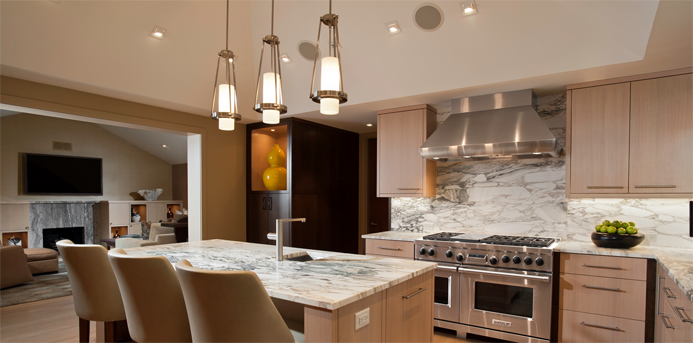If you think lighting a space well is as simple as plugging in a lamp, think again.
Like any design element, careful thought and planning—along with knowing your options—can make the difference between a sterile space and one that offers the perfect marriage of functionality and aesthetics.
We consulted with two industry experts, Tim Archibald, principal architect at Midwest Architecture Studio, and Jamie Myers, designer with the Susan Fredman Design Group, plus the International Association of Lighting Designers, for their thoughts and advice on how to achieve a well-lit space.
Make a Plan
Whether you’re working with an architect or designer or going it alone, you need a lighting plan. Archibald suggests starting with a simple sketch of your room shape. Think about what you want the lighting to do functionally and aesthetically. Make sure to include your furniture, as well as where you will hang art or place treasured objects. Then, after thinking about all the ways you will use that space, indicate where you want light and for what purpose.
Budget: How big a project are you willing to take on? (Cut into your ceiling, floors and walls and hire an electrician? Or just switch out existing fixtures or plug in a few lamps?)
Outlets and wiring: If you’re getting into electrical work, your plan should indicate where you need outlets (wall and floor). Your electrician will map out what type of wiring is required. It’s also a great shopping tool for your designer or sales person at a lighting showroom.
Size and intensity: Defining the space and function ahead of time ensures that you end up with the right sized fixture and intensity of light. For example, if you want adequate reading light next to your bed, the sales person might recommend a swing arm sconce that can take a 40 to 60 watt bulb.
Start at the Top: Overhead Lighting
General overhead lighting is necessary for task-oriented activities and entertaining. To seamlessly add artificial light, Myers recommends recessed or “can” lighting, preferring cans that are only 3 to 4 inches in diameter with trim that matches the ceiling.
If you can’t dig into your ceiling, another option is track lighting—but opt for smaller-scaled track systems for a subtler look. Added benefit? Track fixtures offer more flexibility, allowing you to adjust the spot on the track and the angle of light.
If you want your fixture to add personality, Archibald recommends focal point lighting like a large chandelier, modern fixture, even fixtures with lots of personality or color.
Cove lighting can serve a dual purpose: enhancing the architecture of your space and providing functional lighting. Installed around the perimeter of a room, it brings artificial light into your space without cluttering the ceiling. Cove lighting can also be used as a decorative element to complement furniture design.
No matter what overhead option you choose, always install a dimmer so you can adjust the intensity and control the mood. Dimmers are also a great bang for your buck—saving energy and extending the life of your bulbs.
Filling in the Blanks: Accent and Secondary Lighting
There are times when you want lighting to define a key element, and that’s where accent lighting comes in. For example, if you have built-ins with glass doors or open shelves, adding puck lights can highlight your books, accessories and family photos. (Myers likes LED puck lights for their energy efficiency, bulb life and low heat.) Directional recessed lights can spotlight artwork.
Don’t forget table and floor lamps for working and reading. Lamps add functional and aesthetic value to your room, so don’t be afraid to get creative. Favorite found objects or treasured antiques can be transformed into functional light with style.
Be Energy Wise
Given that lighting consumes 20 percent of all electrical energy in the US, a lot of thought has gone into conservation.
Much of the energy saving spotlight is on fluorescent lighting. And while certainly more efficient, note that fluorescent lighting doesn’t give off the same color as incandescent lighting. IADL reminds us that visible white light is comprised of colors, and whether it’s “cool,” “neutral” or “warm” in appearance, it can affect how we perceive the colors of faces, objects and surfaces.
Fluorescent light tends toward cooler tones (blue/white) that work well for more intensely lit areas and workspaces. But if you want to replicate incandescent lighting, opt for bulbs that offer the warmest color tones possible (orange/yellow/red tones). Myers likes GE’s SP30 bulb for a color tone similar to incandescent lighting. GE also offers an interactive color booth that can help you understand the color difference between all the bulb types now available (www.gelighting.com).
Lead photo courtesy of Tim Archibald, Midwest Architecture Studio

